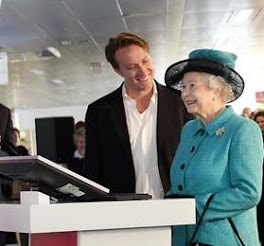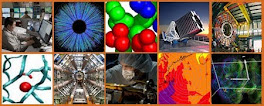 |
| Those clever and inventive medievals didn't just construct cathedrals that stand to this day . |
Can be used to explain a number of anomalies:
1. Lank hair. No
attempt to image real “hair”, merely the imprint that might be left by sweat migrating out of hair of a recumbent subject (capillary action etc).
2. Blood: it was never intended to look like real thick blood - just an anaemic wishy-washy version
thereof, as if sweat had migrated by capillary action through dried blood clots (i.e.the linen acting like 'blotting-paper').
3. No sides to body: gravity would make sweat descend, or ascend via capillary action, so no imprinting of side image onto linen, especially if there were limited physical contact with sides.
4. Cut-off at sides of face. As 3: the sides of the face are vertical, not horizontal.
5. No imaging of top of head:: as 3 and 4: vertical, not horizontal.
6. No imaging of wounds and scourge marks (only blood flows therefrom) – as mentioned in earlier post. Sweat
would not issue from a wound, so there can be no “sweat imprint” of a wound,
only a blood imprint.
More anomalies?? Feel free to suggest ones I've omitted.
 |
| Notre Dame Cathedral Paris: completed 1345 (12 years before the first recorded appearance of another complex artefact (smaller, 2D, but with cryptic 3D properties) in a humble village called Lirey, see below, south of Troyes, also in France)
Lirey church, with the pigeonnier visible on the left
The road sign points to Machy, just 5 minutes by car, where the 'Machy mould' for a second Lirey Pilgrim's badge was discovered by a jogger in a field
The Machy mould, with what I consider to be the addition of an extra feature, not on the Lirey badge, of a representation of the Veil of Veronica above the word SVAIRE i.e. SUAIRE, which can mean either shroud OR face cloth (lettering reversed, being a mould).
Details in close-up.
Monday 17th November
So might there be one of more features of the TS image that serve as a 'smoking gun' for the kind of methodology employed to produce a negative imprint of an entire man on linen, not necessarily from (imagined) "sweat", but probably as sweat?
It's somewhat conjectural at this stage, but my answer to that question would be "maybe", and it's based on a feature on the checklist in the posting immediately preceding this one.
Here's an image from a posting I did a year ago that highlights the problem faced by our medieval imprinter.
Imprint off brass crucifix obtained by LOTTO method (Linen On Top, Then Overlay)
Take a closer look:
There's been no imaging of the neck, leaving a 'floating' head on the image. It may be realistic, as a "simulated sweat imprint", but is somewhat unattractive, making the end-result look too much like the scorch imprint it is, not sufficiently like an imagined sweat imprint, maybe a little idealized and romanticized.
So what are the options for including the neck of the imprinting template, that do not introduce other unwanted features at the same time? Answer: few if any, one suspects. There was a price to be paid for imaging the neck: any run of linen that imaged the neck carried with it a penalty - the underside of the chin had to be imaged too, which looks unnatural on a 3D -> 2D transfer, and there was a risk in turning the linen through a sharp 90 degree angle at the tip of the chin.
But that price was deemed worth paying in order to maintain continuity of image between neck, chin and chest.
Oh well, nothing in this world is perfect...
This blogger has long expressed an interest in the anomalies of the chin/neck region, focusing initially on that transverse 'crease' which is clearly part of the body image, i.e. acquired at the same time as the body image.
Here's a listing (under construction) of previous postings on this 'smoking gun' topic.
http://colinb-sciencebuzz.blogspot.co.uk/2012/02/why-does-turin-shroud-appear-to-have.html
http://shroudofturinwithoutallthehype.wordpress.com/2012/06/15/shroud-scope-4-no-matter-what-process-mysteriously-produced-a-negative-snapshot-of-the-man-on-the-shroud-it-captured-that-of-creases-in-the-linen-too-why-10-2/
http://colinb-sciencebuzz.blogspot.co.uk/2014/03/modelling-two-distinct-types-of-baked.html
http://colinb-sciencebuzz.blogspot.co.uk/2014/07/could-this-be-turin-shroud-image-that.html
Postscript 08:10
This comment has just appeared from Charles Freeman on the shroudstory site in response to Thomas:
Apart from the fact that the TS BODY IMAGE does not fall within the realm of art history (blood additions might, if as I suspect they arrived AFTER body image, in which case they are best treated as a separate issue, and were influenced by artistic considerations) has Charles never asked himself this question: Why was the TS removed so quickly from public display after the first such occasion in recorded history, with the local clergy declaring it to be a CUNNING painting and a forgery. Given it would still have been a recently executed "painting" in 1357, before any fading and deterioration, why would it be described as a "cunning" anything, painting or otherwise, and why branded as a forgery, i.e. fake? The answer of course is that the TS BODY IMAGE is and never was a "painting" in the conventional or any other sense, because it's an IMPRINT, not a painting, and thus outside the remit of art history. The template that we have never seen may have been a legitimate subject for (3D) art history, but at present we don't even know whether it was bas relief, fully 3D, or a cobbled together combination of the two, e.g. bronze statue for the body, bas relief for the head.
Oh, and I'm not trying to revolutionize science. Quite the opposite in fact. I'm applying conventional science to the TS body image, thinking of ways a negative highly superficial image with 3D properties could have been made with those characteristics arriving willy nilly as an accidental byproduct of medieval technology. After some 3 years research and study, I think I have the answer. The aim was to simulate an imaginary sweat imprint as might be left by a traumatized recumbent man on linen. If the technology chosen to produce the pseudo-sweat imprint had been contact scorching from a heated 3D or semi-3D template, maybe with prior impregnation of linen to make it more receptive to thermal imaging, then the negative 3D properties are explained, given they can be produced at will in model systems, as this blogger has demonstrated in the course of some 250 postings since December 2011. How much of my work has Charles read? Or can he not be bothered with other people's scholarly research unless published in a reputable journal (or in Charles's case, a book or periodical)? As I've said before, science is the world of ideas. New scientific ideas, paradigm shifts especially) like my invitation to view the faint-from-the-word-go TS body image as a pseudo-sweat imprint of medieval manufacture, are like genies that escape easily from their bottles. I leave it to those with labs and modern facilities to get released genies back into new bottles. long enough at any rate for their merits and/or demerits to be judged. I'm only here for the science, and leave art history to art historians, assuming they are able to differentiate between art and technology.
09:45 Here's a crucial paragraph from Charles's History Today article. No one has found any significant evidence of the Shroud’s existence before 1355, when it appeared in a chapel at Lirey, in the diocese of Troyes, supposedly advertised there as the burial shroud of Christ. Such sudden appearances of cults were common in a Europe recovering from the trauma of the Black Death. They caused a great deal of frustration for a Church hierarchy anxious to preserve its own status. The bishop of Troyes, Henry of Poitiers, whose responsibility it was to monitor such claims in his diocese, investigated the shrine and reported that, not only were the images painted on the cloth, but that he had actually tracked down the painter. After this clerical onslaught, the Shroud was hidden away for more than 30 years. Yet the Church accepted that it was not a deliberate forgery and in January 1390 the (anti-)pope Clement VII allowed its renewed exposure in Lirey. This suggests that the Shroud may have been credited with unrecorded miracles, thereby acquiring the spiritual status to make it worthy of veneration. Doubtless aware of the earlier claims by the Lirey clergy, Clement insisted that it was publicly announced before each exposition that this was NOT the burial shroud of Christ.The crucial omission note is the description of the TS image as having been "cunningly" painted, long before any obvious fading could have occurred. That omission, and the fact that a newly executed painting, no matter how "cunning" is unlikely to have been mistaken by the first cohorts of pilgrims for a genuine burial shroud makes it exceedingly unlikely that the early TS was seen as a conventional painting, even on historical and dare one say commonsensical grounds. Then there's the matter of the science. Charles seems determined to be seen as the Rip Van Winkle of Shroudology, someone who nodded off in 1978 just as the STURP team were packing their bags and equipment for the trip to Turin, and has only just recently woken up. ;-) xxxxx 11:00: Have just this minute come across this during googling. It's an extract from a book called "The Templars and the Grail: Knights of the Quest" by Karen Ralls. Don't be put off by the title. It's the reference to Veronica-relic fever at roughly the same time as the first display of the Shroud at Lirey that is especially interesting. Might it have been the that display of the Veronica in 1350, described as the "Holy Year" just 7 years before the Lirey display that put the idea in somebody's head of trumping the Veronica with a bigger and better "sweat" imprint? How might that someone have set about simulating a sweat imprint, one wonders? Thinks: it has to be pale yellow or tan, it has to be highly superficial, and NOT look like paint, it has to be a negative image, it should have some "blood" in all the biblically-correct places as well as "sweat", it should be unmistakeable as a burial shroud, even if one has to take artistic liberties ... 12:10 It's now 8 months since I lasted posted to my specialist Shroud site* (not counting the short-lived 'strawshredder' offshoot) . Methinks it's time to update it with the firmed-up ideas re the TS as a carefully-crafted but simulated sweat imprint. That "holy year" 1350 - see above- would make as good a starting point as any, focusing initially on the then extant Veil of Veronica, and whether that much smaller piece of fabric was really a sweat imprint or not, and whether it was a genuine relic from AD33 or not. That would then set the scene for introducing the new paradigm, namely that the TS image was inspired by and derivative of the Veronica. The site could then be abandoned for a few more months, awaiting further ideas and developments, and continuing with this site as a day-to-day worksheet. However, as stated a couple of days ago, I shall no longer be reporting my experiments in real time. It seemed a good idea at the start but has proved to have too many downsides. Any results I get from experimenting with model systems will in future be used to shape or re-shape the central hypothesis, the focus now being on seeking evidence from the TS image that it was purposely designed to be seen as a (pseudo)sweat imprint, and less on the precise mechanism by which that goal was achieved (given that the scorch hypothesis already ticks numerous boxes, and given the poorly-documented basis for many of the labels on those boxes anyway as regards image location, image superficiality, microscopic aspects etc etc). *59 visits today so far, though visits sadly do not translate into Google ranking, or if they do, they are a poor relation in the ranking algorithm. 22:15 Monday. Job done. have just posted to my old specialist TS site, the first since March. The Google ranking jumped instantly from page 25 to page 16, which tells you something about the way the ranking algorithm works. Update November 21st. That Google ranking can be Page 13 or even Page 9 briefly under a (shroud of turin) search yet Page 26 a few hours later. That really says all one needs to know about the stability and quality control of the Google algorithm. I for one shall not waste another second with 'meegling my own content, since apart from being narcissistic, it's a TOTAL WASTE OF TIME AND ENERGY. What has been far more valuable has been googling (shroud sweat imprint). Most of the first listed entries refer to my current thinking, arrived at circuitously some might think through initially following the scorch -> barbecued Templar route, and finally arriving at a 'scorch as simulated sweat imprint' conclusion, a considered view that is now setting rock hard in this sceptic's mind like concrete. However, a chance finding in that list was a Google books link to Ian Wilson's "The Shroud" (2010) which has a few 'free sample' pages that would seem prescient, despite his final conclusions and take-away message being entirely the opposite of mine, namely that the TS image IS genuine. Why prescient? Sweat and sweat imprints still feature strongly in his view, though I have still to press the appropriate keys to acquire and read his entire book (which won't be a chore, if only for his enviable style of writing). Having given his book a puff, I hope he and his publishers won't object to my posting here a screen grab of some of those free pages on view already. .
Page 30 from Ian Wilson's "The Shroud" (2010)
Page 31 from same .
I see this posting has been described as the "Conspiracy of the Faux Sweat Imprint".
That "conspiracy" term always carries connotations, faintly pejorative ones. What I'm proposing is not so much a conspiracy, more a confidence trick. Naturally the organizers need to keep things to themselves, but that's not quite the same as "conspiracy".
Saturday 22nd November
There's a new post gone up on shroudstory.com in which French-Canadian Yannick Clément ask when and why the TS image first became seen as one captured at the instant of Resurrection, as distinct from a natural phenomenon associated with enveloping a corpse in linen.
My answer - for what it's worth: it happened when certain "scientists" (I use the term loosely, since it's generally engineers dabbling in science) decided to dismiss natural causes or medieval forgery with indecent haste, and began to speculate on intense bursts of radiation, conveniently collimated so as not to require all the paraphernalia of lenses etc. But normal corpses don't emit radiation, do they? So it had to be supernatural radiation, and what better time to emit that supernatural radiation than during a process of dematerialization that we call Resurrection.
It's a completely circular argument, needless to say. It needed that supernatural 'resurrection' to generate the necessary and entirely hypothetical radiation (wavelength conveniently unspecified) and with it the image. But the image could "only" have been formed by radiation which therefore offers overwhelming evidence (or so we are told) of a supernatural event, i.e. Resurrection.
So, to summarize, the Resurrection provided the radiation, and the radiation formed the image, and the image could only have been formed by radiation, so there had to be a Resurrection to provide the radiation, which formed the image, which must have needed radiation, which must have come from Resurrection, which generated the radiation... oops, there's someone knocking at the door, must see who it is, back later...
|
































No comments:
Post a Comment